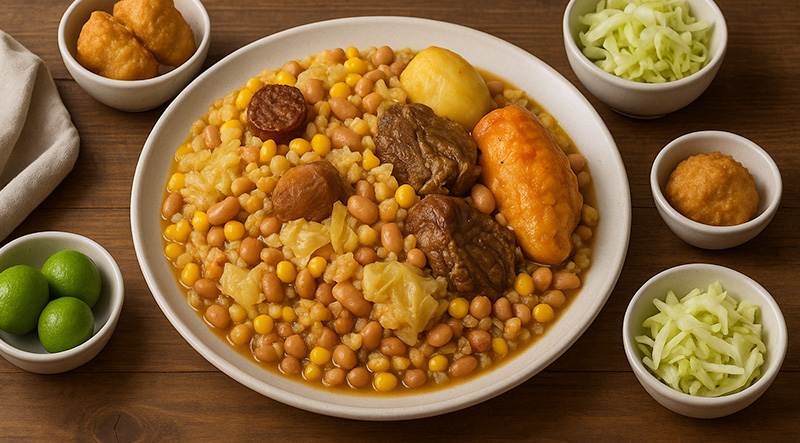Cachupa, the beloved national dish of Cabo Verde, is a soulful stew that tells the island's story in every savory bite. Slow-cooked to perfection, this hearty blend of hominy corn, beans, sweet potatoes, cabbage, and tender meats or fish is a celebration of Cape Verdean tradition and flavor. Whether enjoyed in its rich "refogada" version the next day or served hot and fresh straight from the pot, Cachupa is more than a meal—it's comfort, culture, and community all simmered into one irresistible dish. Read More...
The History of Cachupa: The Beloved National Dish of Cabo Verde
Cachupa is more than just a dish in Cabo Verde—it is a cultural symbol, a reflection of resilience, heritage, and communal life. Its roots stretch deep into the islands’ history, born from a blend of African, Portuguese, and indigenous culinary influences that reflect the archipelago’s complex past.
The origins of Cachupa can be traced back to the early days of Portuguese colonization in the 15th century, when enslaved Africans and European settlers brought together a fusion of ingredients and cooking methods. On the arid islands of Cabo Verde, food scarcity was common, and locals learned to create nutritious, filling meals from what was available. Corn (maize), a staple brought from the Americas, became a key base for Cachupa, complemented by beans, sweet potatoes, cassava, and seasonal vegetables. These ingredients were slowly simmered into a thick, comforting stew. When possible, meat such as pork, sausage, or tuna was added, giving the dish depth and richness.
Cachupa evolved into two primary forms: Cachupa Rica, which includes an abundance of meats and vegetables and is typically reserved for special occasions, and Cachupa Pobre, a simpler version with fewer ingredients, representing the resourcefulness of everyday island life. No matter the variation, the dish has remained a unifying culinary tradition—often prepared in large pots to be shared among families, neighbors, and communities.
Over the centuries, Cachupa became a symbol of identity and pride for Cabo Verdeans, especially in the diaspora. It is frequently served at celebrations, festivals, and gatherings, where its aroma alone evokes nostalgia and a sense of belonging. Even internationally renowned Cape Verdean artists like Cesária Évora helped elevate Cachupa’s cultural status by referencing it in music and interviews, connecting the food to the soul of the nation.
Today, Cachupa remains a beloved staple in Cabo Verde, cherished not just for its taste but for the history and humanity it carries. Each spoonful is a reminder of the islands’ journey—marked by struggle, adaptation, and the warmth of community.
Soak legumes (if using dried):
Soak the dried hominy and kidney beans overnight in separate bowls. Drain and rinse before cooking.
Cook the beans and corn:
In a large heavy pot, add the hominy corn, beans, and enough water to cover. Simmer for 1 to 1.5 hours until tender (or 30–40 minutes in a pressure cooker). Skim off any foam.
Brown the meats:
In a separate pan, heat olive oil. Sauté the chopped onion and garlic until fragrant. Add pork, sausage, and bacon. Brown until edges are golden.
Combine everything:
Transfer the browned meats, sautéed onion/garlic, bay leaves, paprika, and salt/pepper into the pot with the corn and beans. Stir well.
Add vegetables:
Add carrots, potatoes, sweet potatoes, cabbage, and pumpkin (if using). Add enough water or broth to cover everything. Simmer gently for another 30–45 minutes, until veggies and meats are tender.
(Optional) Add fish:
If using fish, add it in the final 10–15 minutes of simmering so it doesn’t fall apart.
Adjust seasoning:
Taste and adjust salt, pepper, or paprika. Let rest for a few minutes off the heat.
Serve:
Spoon generously into bowls. For Cachupa Refogada (refried), refrigerate overnight, then fry scoops of the stew in a bit of oil the next day until crispy and serve with a fried egg on top.

Tips:
Enjoy this warm and flavorful dish that captures the essence of Cabo Verde in every bite!
The total preparation and cooking time for Cachupa is approximately 3 to 4 hours, depending on the ingredients and whether you’re using dried or canned beans and corn. Soaking the dried legumes overnight is essential and adds time in advance. Active prep—chopping vegetables, browning meats, and assembling the stew—takes about 30 to 45 minutes. Simmering the dish for deep flavor and tenderness requires 2 to 3 hours, though using a pressure cooker can significantly reduce this to about an hour. Cachupa is a slow-cooked labor of love, best prepared when you have time to let it simmer to perfection.
A single serving of Cachupa, based on the traditional recipe provided (including pork, sausage, beans, corn, and vegetables), contains approximately 500–650 calories. The calorie count can vary depending on the cut of meat used and whether additional ingredients like bacon, sweet potatoes, or eggs (for Cachupa Refogada) are included. The bulk of the calories come from the hominy corn and beans, which are rich in carbohydrates and protein, as well as the fatty meats like sausage and bacon. For a lighter version, reducing the amount of meat or skipping the egg topping can lower the calorie count per serving.







